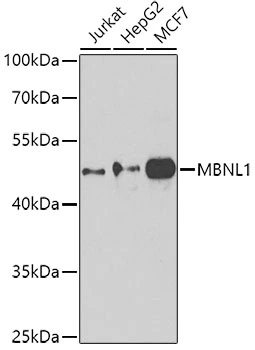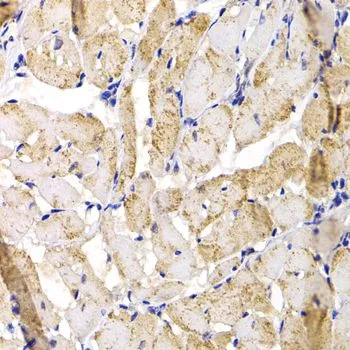
WB analysis of various sample lysates using GTX33335 Muscleblind-like 1 antibody. Dilution : 1:1000 Loading : 25microg per lane
Muscleblind-like 1 antibody
GTX33335
ApplicationsImmunoFluorescence, Western Blot, ImmunoCytoChemistry, ImmunoHistoChemistry, ImmunoHistoChemistry Paraffin
Product group Antibodies
TargetMBNL1
Overview
- SupplierGeneTex
- Product NameMuscleblind-like 1 antibody
- Delivery Days Customer9
- Application Supplier NoteWB: 1:500 - 1:2000. ICC/IF: 1:50 - 1:100. IHC-P: 1:50 - 1:200. *Optimal dilutions/concentrations should be determined by the researcher.Not tested in other applications.
- ApplicationsImmunoFluorescence, Western Blot, ImmunoCytoChemistry, ImmunoHistoChemistry, ImmunoHistoChemistry Paraffin
- CertificationResearch Use Only
- ClonalityPolyclonal
- ConjugateUnconjugated
- Gene ID4154
- Target nameMBNL1
- Target descriptionmuscleblind like splicing regulator 1
- Target synonymsEXP, MBNL, muscleblind-like protein 1, muscleblind-like, triplet-expansion RNA-binding protein
- HostRabbit
- IsotypeIgG
- Protein IDQ9NR56
- Protein NameMuscleblind-like protein 1
- Scientific DescriptionThis gene encodes a member of the muscleblind protein family which was initially described in Drosophila melanogaster. The encoded protein is a C3H-type zinc finger protein that modulates alternative splicing of pre-mRNAs. Muscleblind proteins bind specifically to expanded dsCUG RNA but not to normal size CUG repeats and may thereby play a role in the pathophysiology of myotonic dystrophy. Mice lacking this gene exhibited muscle abnormalities and cataracts. Several alternatively spliced transcript variants have been described but the full-length natures of only some have been determined. The different isoforms are thought to have different binding specificities and/or splicing activities. [provided by RefSeq, Sep 2015]
- Storage Instruction-20°C or -80°C,2°C to 8°C
- UNSPSC12352203
References
- Mice lacking MBNL1 and MBNL2 exhibit sudden cardiac death and molecular signatures recapitulating myotonic dystrophy. Lee KY et al., 2022 Sep 10, Hum Mol GenetRead more







